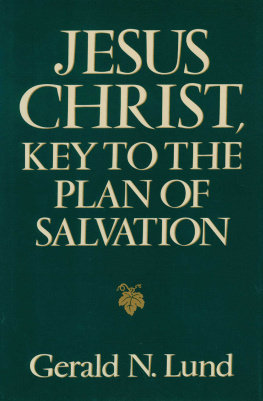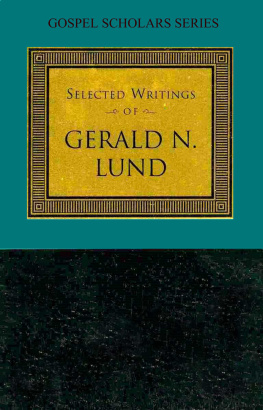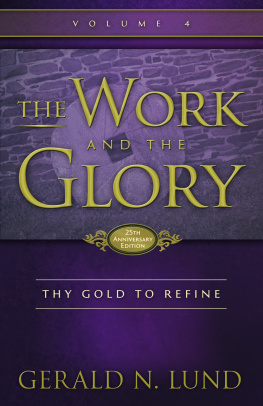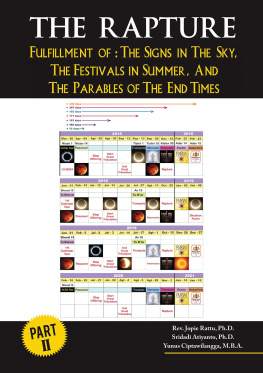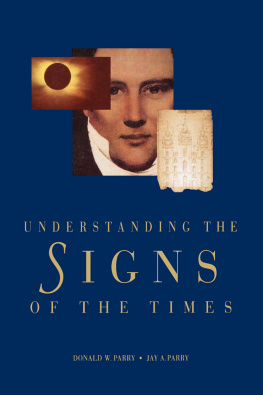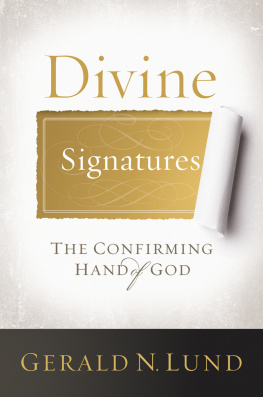2020 GNL Enterprises, LP
All rights reserved. No part of this book may be reproduced in any form or by any means without permission in writing from the publisher, Deseret Book Company, at permissions@deseretbook.com or P. O. Box 30178, Salt Lake City, Utah 84130. This work is not an official publication of The Church of Jesus Christ of Latter-day Saints. The views expressed herein are the responsibility of the author and do not necessarily represent the position of the Church or of Deseret Book Company.
Deseret Book is a registered trademark of Deseret Book Company.
Visit us at DeseretBook.com
Library of Congress Cataloging-in-Publication Data
Names: Lund, Gerald N., author.
Title: The second coming of the Lord / Gerald N. Lund.
Description: Salt Lake City, Utah : Deseret Book, [2020] | Includes bibliographical references and index. | Summary: Noted Latter-day Saint author Gerald N. Lund examines Restoration and earlier prophecies about the Second Coming of the Lord Jesus ChristProvided by publisher.
Identifiers: LCCN 2020022743 | ISBN 9781629728209 (hardback) | eISBN 978-1-64933-008-6 (eBook)
Subjects: LCSH: Second Advent. | End of the world. | The Church of Jesus Christ of Latter-day SaintsDoctrines. | Mormon ChurchDoctrines.
Classification: LCC BT886.3 .L86 2020 | DDC 236/.9dc23
LC record available at https://lccn.loc.gov/2020022743
Printed in the United States of America
Lake Book Manufacturing, Inc., Melrose Park, IL
10 9 8 7 6 5 4 3 2 1
Book design Deseret Book Company
Cover image Malika Keehl / Shutterstock.com
Art direction: Richard Erickson
Design: Emily Remington
Contents
Preface
Beginnings
In the summer of 1969, my wife and I and our four young children packed our station wagon and a trailer and headed for California. After five years as a seminary teacher, I was going to be an institute instructor at a junior college in Southern California. It was a big step for us, and we were both excited and a little apprehensive. Our five years there proved to be a wonderful experience for us. It also led to something totally unexpected.
Early in my seminary career, I developed an interest in prophecy and the signs of the times and began collecting quotes and scriptures on the subject. That only intensified as I began teaching institute classes. Seminary and institute teachers are often asked to speak at various Church functionsfiresides, youth conferences, etc. Because of my interest, I often chose to speak on prophecy and the signs of the times.
In doing so, an interesting thing began to happen. Often people would come up afterward and ask how they could get copies of the quotes I had used. When I explained that I had drawn most of them from sources in the Brigham Young University library, they were disappointed that the quotes werent more readily accessible. Their next question was often, So, why dont you write a book about this?
At first I brushed it off. I wasnt an author and had no aspirations to be one, so writing a book on the subject had not occurred to me. But the thought did intrigue. One night, on the way home from a fireside, my wife asked what I thought about that frequent question. When I told her I found the idea intriguing but intimidating, she brushed that aside with a three-word response: Just do it.
Fortunately, I had already done most of the research, and so I set to work immediately. Several months later, I sent off a manuscript to a publisher in Salt Lake City, and in 1971, The Coming of the Lord was published. I had become an author.
It is ironic to me that this happened fifty years ago now. And to my great surprise, the book has been in continuous print ever since. It has been gratifying to know that this is a gospel topic of great interest to many people over multiple generations.
Over those next five decades, my interest in prophecy and the signs of the times only increased. And even though the book was still in print, I began wondering if I should consider doing an updated version of the book. Two oft-asked questions kept that idea on my mind.
The first question: Have you considered updating The Coming of the Lord ? That was easy. Yes, I had been thinking about it for some time. People encouraged me to do so. But the second question took me aback at first. So, if you do update it, how will it be different?
There were several answers to that, but two were the most compelling. As already noted, the book had been published in 1971. David O. McKay, the ninth President of the Church, was the prophet when I started writing. He died before I had finished the book. One of the primary objectives I had when I first wrote the book was to heavily emphasize the scriptural passages on this topic and to see what prophets ancient and modern had said about it.
Our current prophet, President Russell M. Nelson, is the seventeenth President of the Churchwhich means that we have had eight additional prophets! And in addition to the prophets themselves, think how many additional Apostles and counselors in the First Presidency we have had in the last fifty years. This means that there was a treasure trove of new prophetic commentary that hadnt been available when I wrote the book. That was a huge factor in my decision to update it.
The second reason may not be quite so compelling, but it is an important one nevertheless. As the years passed and I mentioned to people who asked that I was considering doing a major revision, they asked me one question again and again: What would you do differently in the new edition? I mentioned the amount of new material there was, but there was something else too. And it has to do with the relationship between history and prophecy.
A colleague of mine in the Church Educational System once noted that history and prophecy were different ends of the same timeline. He also noted that the line between the two was constantly shifting. Meaning, what had once been prophecy was now history. In other words, some of the things I discussed in The Coming of Lord were treated as prophetic promises, whereas in this new edition, some of those same things will now be discussed as history, or history in the process of being fulfilled. That change is of no small significance.
Here is one dramatic example of that. As a boy in my teens, I had always planned on serving a mission. My friends and I often speculated about where our mission calls might take us. A question often heard at that time was, Do you think we will ever see missionaries called to Russia? The most common answer was, Not likely. Not until after the Millennium begins.
Well, we were wrong! Russia began letting the Church have a legal presence in the country in the early 1990s. As we shall see in this book, that history has continued to the point where we have a number of faithful Church congregations there, and recently, President Nelson announced that a temple will be built in one of the major cities of Russia.
There is a dynamic synergy between history and prophecya synergy that we shall see again and again throughout the book.
Unfolding Prophecy
This brings me to one last introductory point before we turn to some practical considerations about the book. After years of gathering and filing material on prophecy and the signs of the times, I formally began work on this new edition. Not long after that, we also chose a new title for it: The first edition was The Coming of the Lord. This edition is titled The Second Coming of the Lord .





